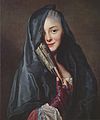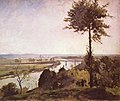Swedish National Museum
The Swedish National Museum is Sweden's largest art museum. The building in Stockholm houses around 16,000 paintings and sculptures, as well as around 30,000 handicrafts and a world-class graphic collection. The National Museum also manages the works of art in many castles, for example Gripsholm , Drottningholm , Strömsholm , Rosersberg and Ulriksdal , as well as the porcelain museum in Gustavsberg .
General
The history of the collections goes back to the 16th century. Gustav Wasa laid the foundation for a royal art collection at Gripsholm Castle, which grew rapidly through purchases, donations and spoils of war. However, the abdicated Queen Kristina took many of the Italian works of art to Rome in 1654. A castle fire on Tre Kronor in 1697 destroyed other parts of the collection. In the 1740s, the Swedish ambassador to Paris, Carl Gustaf Tessin , bought many high-ranking French works from this era for the royal collection. After the death of Gustav III. In 1792, the National Museum was donated in his memory, whereby the collections became the property of the general public. The current building was designed by the German architect August Stüler . The opening took place in 1866.
The collection includes masterpieces of Dutch art of the 17th century, such as Rembrandt's “Kitchen Maid”, and French art of the 18th century, such as Antoine Watteau's “Love Lesson”. Swedish art is represented from the 16th to the early 20th centuries, with works such as “Lady with a Veil” by Alexander Roslin and the “Midsummer Dance” by Anders Zorn .
The collection of graphic and hand drawings comprises around 500,000 sheets from the late Middle Ages to the 20th century. Its core consists of over 2000 master drawings, acquired by Carl Gustaf Tessin during his time as an ambassador. The holdings of Rembrandt, Watteau, Édouard Manet , Johan Tobias Sergel , Carl Larsson , Carl Fredrik Hill and Ernst Josephson are particularly significant .
The handicraft collection spans an arc from the 14th century to the present day. The focus is on objects from Sweden and the Scandinavian countries, but many other countries are also represented. One third of the collection is made up of ceramics.
Around 15 percent of the collections are recorded in a research database on the museum's website. As in 15 other state museums, admission to the permanent exhibition has been free since 2016.
The stair hall
In 1883 a committee was created to determine how the walls of the staircase hall of the National Museum should be decorated. There was a competition of several proposals for this decision and in 1886 the council agreed to design the hall with motifs from Swedish history . The lower area was supposed to show events from the 16th to 18th centuries and the upper part was reserved for motifs from the Middle Ages and prehistoric times. The Swedish government approved this proposal and expanded the body to twelve members. The committee now included Fritz von Dardel , Johan Nordenfalk , Nils Fredrik Sander , Gustaf Upmark , Per Daniel Holm , Georg von Rosen , Carl David af Wirsén , Helgo Zettervall , John Börjesson , August Malmström , Viktor Rydberg and Carl Curman .
At the end of 1888, sketches with suggestions for the design of the walls were submitted as part of a competition. Gustaf Cederströms' proposal “Ansgarius preaches Christianity” won for the upper staircase hall and Carl Larsson's proposal “Karl XII. considers in Bender Ticino's plans for the Stockholm Palace ”,“ Linné with Queen Ulrika in the park of Drottningholm ”and“ Sergel in his studio, a statue of Gustav III. modeling ". However, the committee was not entirely satisfied and started another competition in June 1890. Larsson sent suggestions for all wall surfaces for this purpose. His recommendations for the upper hall, “Gustav Wasa's entry into Stockholm on Midsummer's Day 1523” and “Gustav II Adolf's shore leave in Pomerania 1630”, won first prize. Second prize went to Georg Pauli's version of “Gustav Wasa's Entry into Stockholm” and his “Olof Skötkonung's baptism”.
In the fall of 1891, the committee decided to commission Cederström to decorate a wall in the upper hall with his work on Ansgar . The committee did not reach a unanimous decision, but the majority of the members were in favor of designing the upper hall with Ansgar and another motif from early history and sent this proposal to the government. Before the government could react, several Swedish artists submitted a protest note in the summer of 1892. In that letter, the panel's proposal was declared unsatisfactory and, by and large, Carl Larsson's proposals were presented as the better alternative. Among the 35 signatories were the artists Prinz Eugen , Geskel Salomon , Richard Bergh , Georg Pauli and Anders Zorn .
After further negotiations between the committee, the government and the Swedish Art Academy , the latter ordered that works on Gustav Wasa and Gustav II Adolf be shown in the upper hall. This resolution was ratified by the government on February 2, 1894. However, the order for the Gustav Wasa motif went to Cederström, who refused this request, as he did not want Carl Larsson's work "Gustav Wasas Einzug" to be sacrificed.
Carl Larsson received the official order to make three cardboard boxes for walls in the lower hall. In early 1896, the board ordered cardboard boxes for the remaining three walls in the lower hall. Larsson received 25,000 crowns per painting for this work . The six wall surfaces were decorated in the summer of 1896 with Larsson's works “Ehrenstrahl paints a portrait of Karl XI.”, “Schlossbau mit Nicodemus Tessin d. J. and Carl Hårleman ”,“ Queen Lovisa Ulrika and Carl Gustav Tessin ”(the founders of the Swedish art collecting system),“ Gustav III, the protector of art and museum founder, accepts ancient works of art ”,“ Bellman in Sergel's studio ”and“ Taravals Drawing School ”(The Foundation of the Art Academy). The committee was not completely satisfied with the way the work was carried out and wanted to change some details. Finally, the paintings were "accepted" but not fully "endorsed".
The decision on the upper hall was still pending. It was not until 1905 that Larsson was commissioned to design a wall with “Gustav Wasa's entry into Stockholm”, which happened in the summer and autumn of 1907. In 1910 Carl Larsson had a completely new inspiration for the design of the last free wall. He wanted to design the area with a motif from the Swedish world of legends. In February 1911 a sketch for his painting “ Midvinterblot ” was on view in the National Museum. This work was to develop into Sweden's most discussed painting. A long-lasting series of critical contributions in letters and newspaper articles caused Larsson in 1914 to completely turn away from the National Museum project.
Regardless of that, he painted Midvinterblot in his studio in Hyttnäs at his own risk. The work was temporarily shown in the National Museum in June 1915 and the debate started again. Despite a well-attended presentation at the inauguration of Lijevalch's art gallery , the work disappeared for 40 years in the archives for decorative art in Lund . After an odyssey about Sotheby’s in London and the art collector Hiroshi Ishizuka in Japan, several Swedish foundations supported the National Museum, which in the summer of 1997 became the current owner of the painting for 14.6 million crowns. Since then it can be seen across from “Gustav Wasa's Entry into Stockholm”.
Exhibited works
(Selection)
literature
- Georg Nordensvan : Carl Larsson . In: Svensk konst och svenska konstnärer i nittonde århundradet . Ny, Grundligt omarbetad upplaga - New, thoroughly revised edition. tape 2 : II. Från Karl XV till sekelslutet . Albert Bonniers Verlag, Stockholm 1928, p. 227-228, 275-280, 341-353, 447-448 (Swedish, runeberg.org ).
- Georg Nordensvan: Carl Larsson. Part 2: 1890-1919. Norstedts, Stockholm 1921.
Web links
- Swedish National Museum (Swedish and English)
- Literature from and about Nationalmuseum in the catalog of the German National Library
Individual evidence
- ↑ Georg Nordensvan : 3. Carl Larssons verksamhet i hemlandet . In: Svensk konst och svenska konstnärer i nittonde århundradet . Ny, Grundligt omarbetad upplaga - New, thoroughly revised edition. tape 2 : II. Från Karl XV till sekelslutet . Albert Bonniers Verlag, Stockholm 1928, p. 344 (Swedish, runeberg.org ).
- ↑ Georg Nordensvan : 3. Carl Larssons verksamhet i hemlandet . In: Svensk konst och svenska konstnärer i nittonde århundradet . Ny, Grundligt omarbetad upplaga - New, thoroughly revised edition. tape 2 : II. Från Karl XV till sekelslutet . Albert Bonniers Verlag, Stockholm 1928, p. 346 (Swedish, runeberg.org ).
- ^ Nordensvan: Carl Larsson. Part 2: 1890-1919. 1921, p. 23.
- ^ Nordensvan: Carl Larsson. Part 2: 1890-1919. 1921, pp. 26-27.
- ^ Nordensvan: Carl Larsson. Part 2: 1890-1919. 1921, pp. 43-45.
- ^ Nordensvan: Carl Larsson. Part 2: 1890-1919. 1921, pp. 145-148.
- ↑ Lisa Blohm: National Monument åter svenskt. In: Svenska Dagbladet . July 9, 1997.
Coordinates: 59 ° 19 ′ 43 ″ N , 18 ° 4 ′ 39 ″ E











